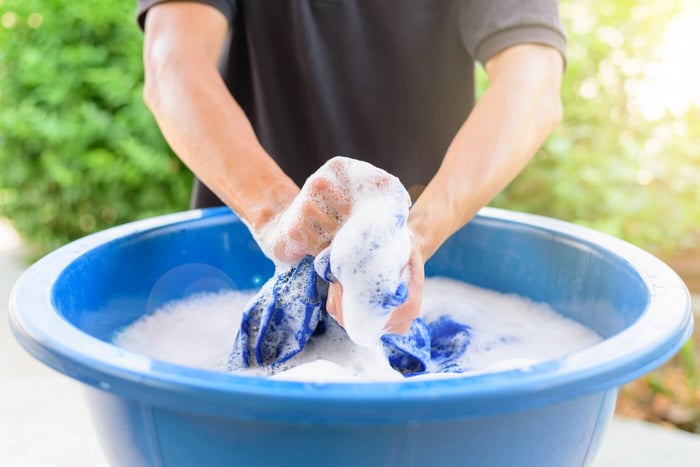 Why Switch From Dry Cleaning to Green Dry Cleaning?
Why Switch From Dry Cleaning to Green Dry Cleaning?
Dry cleaning is a process that uses chemicals to clean clothes. These chemicals are very harmful to the environment and can cause different types of cancer. The dry cleaning industry has been trying to switch to green dry cleaning for a while now but it still isn't as popular as it should be. Green dry cleaning is an eco-friendly way of getting your clothes cleaned without using any harmful chemicals that pollute the environment and cause cancer. There are other ways of getting your clothes clean that don't pollute the environment but are much more time-consuming. Green dry cleaning uses natural materials to clean clothes which is an environmentally-friendly option. It uses no harsh chemicals and is safe for the planet. The solution itself is also non-toxic, meaning it won't harm the environment when it's disposed of.
Nori’s innovative Nori Steamer is a great alternative to traditional dry cleaning. It gives you full control and ease of ironing your clothes. The Nori Steamer Iron is designed to press, steam & refresh your clothes with ease. Built In Steamer. 2X Faster Iron Process. 8ft Power Cord.
Attention: Use discount code "SHOP10" at checkout to save 10% on The Nori Press!
Why Is Dry Cleaning So Bad For The Environment?
Dry cleaning is a process of cleaning clothes in a chemical solvent. It's done by soaking clothes in a waterless chemical solution, which may be ultrasonic.
The process is usually done for fabric items that are made from natural fibers such as silk, wool, and cotton.
The dry cleaning industry has been around for over 100 years and it has been an environmentally friendly service for the past two decades. But now the dry cleaning industry is going through some changes which are making it less environmentally friendly than before.
The purpose of this article is to inform readers about the changes that are happening in the dry-cleaning industry and how they might affect them as consumers and as people who use dry-cleaning services professionally. What are the changes in the dry-cleaning industry? There is a growing divide between what consumers are willing to pay for, and what the industry is able to provide. This has led many companies to charge more for dry-cleaning garments than they used to coles down. It has also led some dry cleaners, who are at the end of their financial ropes, or who no longer want to operate in compliance with new regulations, to open their own unlicensed operations.
The Pros & Cons of Dry Cleaning as an Ecological Choice
When it comes to dry cleaning, there are many pros and cons to consider. It is an eco-friendly process when done at a high level of quality without risks to humans or the environment.
Dry cleaning is not as eco-friendly as people may think because it uses a lot of chemicals. The chemicals used in the process are toxic and can cause harm to the environment if they are not disposed of properly.
Dry cleaners use less water than regular laundries, which is an ecological advantage for them. However, this advantage doesn't outweigh the negatives that come with dry cleaning such as the use of harmful chemicals and reduced air quality due to chemical use in the process. Wet cleaning is more effective than dry cleaning. Wet cleaning in general uses less water, harmful substances, and chemicals. It is also better at retaining the shape of garments and can be done on a variety of fabric types without damage. The use of chemicals that are not as harmful to the environment or to people's health may outweigh the negatives associated with wet cleaning. The disadvantages of wet cleaning are that it may be time-consuming, and the chemicals used are potentially harmful to the environment. Dry cleaning is convenient because it does not require the use of water. This makes dry cleaning environmentally friendly and production-friendly. However, wearing clothes that have been dry cleaned can put chemical residues from the cleaners on your skin, and into the environment, when disposed of. Another disadvantage of dry cleaning is that it is not as effective as wet methods at removing stains or odors.
Dry Cleaners and Your Risk of Developing Cancer
The dry cleaning process has been associated with the development of cancer, but there are not enough studies to confirm this. The use of dry cleaning agents can lead to the release of carcinogenic chemicals such as tetrachloroethylene and perchloroethylene, which can be found in the air inside the store or on your clothes after you have left the store. If you suspect that you have been exposed to these chemicals, talk to your doctor. Dry cleaning chemicals can also dissolve into the soil and enter the well water supply, leaving a toxic residue of dry cleaning chemicals in areas around where dry cleaned clothes are taken for laundering.
Dry Cleaners and Toxic Dyes - Are They Really Safe?
The use of toxic dyes in clothes from dry cleaning is an issue that has been raised for a long time. But the debate has been reignited with recent studies showing that toxic dye exposure in clothes from the environment can be a significant public health risk.
The debate on whether or not to ban toxic dyes in clothes from dry cleaning has been reignited with recent studies showing that toxic dye exposure in clothes from the environment can be a significant public health risk. There are many people who believe that this is just not enough evidence and want more research done before they take any action. But what we do know is that there are many people who are already experiencing serious health effects due to their contact with these chemicals. .People with color vision deficiencies, such as those with red-green color blindness, are especially at risk for serious health effects from their contact with the dyes. But what about people without color vision deficiencies? There is also evidence suggesting that people that work in the textile dyeing and finishing industry have a higher rate of cancer than other populations.
The Solution: Green Dry Cleaning
 Green dry cleaning uses natural materials like vinegar, baking soda, and lemon juice to clean clothes. This method is safer than traditional methods because there are no toxic chemicals involved in the cleaning process. The solution itself is made from ingredients that are found around the house such as vinegar, baking soda, lemon juice, and water. The solution is sprayed onto the clothing and then left to soak up all the dirt and stains. Once the solution has soaked into the fabric, it is removed by hand or machine. When you're done, just throw away the leftover solution and wash the clothes again if necessary.
Green dry cleaning uses natural materials like vinegar, baking soda, and lemon juice to clean clothes. This method is safer than traditional methods because there are no toxic chemicals involved in the cleaning process. The solution itself is made from ingredients that are found around the house such as vinegar, baking soda, lemon juice, and water. The solution is sprayed onto the clothing and then left to soak up all the dirt and stains. Once the solution has soaked into the fabric, it is removed by hand or machine. When you're done, just throw away the leftover solution and wash the clothes again if necessary.
What Is ‘Green' Dry Cleaning?
Dry cleaners are notorious for their harmful effects on our environment. They emit dangerous fumes into the air, and some even use hazardous chemicals to clean our clothes. But now there is another option that is safer for both us and the planet.
According to the Environmental Protection Agency, dry cleaning releases significant carbon dioxide and volatile organic compounds (VOC) that may affect dry cleaner employees, their families, and customers, during normal operations. The EPA estimates that the average American spends $1,500 each year on dry cleaning alone. If we encourage dry cleaners to change to green dry cleaning methods and stop buying dry-cleaned items, we can save money and help protect the environment.
There are many alternatives to dry cleaning. Cold pressers use natural products such as water and soap. Steam cleaners don't use any chemicals at all. And "green" dry cleaners use no harsh chemicals either. Instead, they use biodegradable detergents and recyclable materials.
If you decide to go the eco-friendly route, make sure to check out the environmental impact of every step involved in the process. For example, do you know how much energy goes into producing your favorite brand of laundry detergent? Do you know what happens to the bottles once you throw them away? How does the fabric care product affect the environment?
The best thing you can do is educate yourself about the issues surrounding dry cleaning. Then, choose wisely.
Benefits of Green Dry Cleaning:
There are many benefits to switching to green dry cleaning. Some of these include:
1) No Harmful Chemicals - Using natural solutions instead of chemical ones means that there will be no harmful chemicals being released into the air. This is good news for the environment and people living nearby.
2) Safer Clothes - By using natural cleaners, you'll be able to keep your clothes cleaner and fresher longer. You won't have to worry about them smelling bad or having spots appear on them.
3) Less Waste - Since the solution is biodegradable, you won't need to dispose of it properly. Instead, you can simply use it again and again until it runs out.
4) Save Money - If you decide to go green, you'll save money over time since you won't have to buy new chemicals every year.
5) More Eco-Friendly - Going green is better for the environment so you'll feel good knowing that you're doing something good for Mother Earth.
6) Better For Your Health - Natural cleaners are healthier for you than chemical ones. They contain fewer toxins and are less likely to cause health problems.
Attention: Use discount code "SHOP10" at checkout to save 10% on The Nori Press!
Green Cleaners are Better for the Environment
Dry cleaners are not eco-friendly. They use a lot of chemicals to clean clothes and they release toxins into the air and water. This is a major concern for many people because dry cleaners are so prevalent in our society.
Green cleaners, on the other hand, use natural cleaning methods such as steam to clean clothes. They also do not use any harmful chemicals which is better for the environment.
The best way to find out if your local dry cleaner uses green cleaning methods is by asking them. If you don’t know where to start, here are some questions that will help you figure it out:
- Do you use environmentally friendly products?
- Are you able to provide me with information about what kind of cleaning method you use?
- How often does your company recycle its waste?
- What happens to the used solvents after they've been cleaned?
If you get answers to these questions, you should be able to tell whether or not your dry cleaner uses green cleaning techniques.
How does Green Dry Cleaning Work?
In order to understand how dry cleaning works, you first need to know what happens during normal washing. When you wash your clothes, they go through several steps before being dried and put away. First, they are soaked in a solution called detergent. Detergents break down the oils and fats found on your clothing and make them easier to remove. Next, the clothes are rinsed in hot water to remove the soap and detergent. Finally, they are placed in a machine that dries them.
When you perform a dry cleaning service, the process is similar except that instead of soaking the clothes in detergent, they are immersed in a mixture of solvents and water. The solvents are then removed and the clothes are left to dry naturally.
There are two types of solvents commonly used in dry cleaning: petroleum-based solvents and vegetable oil-based solvents. Petroleum-based solvents are considered toxic and are known to cause cancer. Vegetable oil-based is non-toxic but does contain traces of carcinogens. They are still better than using chlorofluorocarbons (CFCs) which were once widely used in dry cleaners. CFCs are now banned due to their harmful effects on the ozone layer.
There are many different ways to clean clothes using green dry cleaning methods. Some companies use steam cleaning while others use ultrasonic technology. Steam cleaning involves placing the clothes in a sealed chamber where heat is applied to the inside of the chamber. This causes the air pressure to increase, forcing out all the moisture from the clothes. Ultrasonic cleaning uses high-frequency This allows the liquid to penetrate into the fibers of the material.
Green dry cleaning is becoming increasingly popular among consumers. However, there are some drawbacks to this method. For one thing, it is expensive compared to regular dry cleaning. Also, it takes longer to complete the job since the clothes must be cleaned and dried separately.
Conclusion: Reasons You Should Give Green Dry Cleaners a Try
Dry cleaning is a process that uses chemicals to clean clothes. It was invented in the 1900s and has been used ever since. Dry cleaning is a fast, effective and inexpensive way to clean clothes by removing dirt, sweat stains, and other residues from clothing. However, it can also cause damage to the environment and human health.
There are many eco-friendly dry cleaners that use water instead of chemicals to clean your clothes. These dry cleaners have been around for decades but have recently become popular again due to public awareness of their benefits. Switching over to green dry cleaners will save you time, and money and help preserve our environment!








